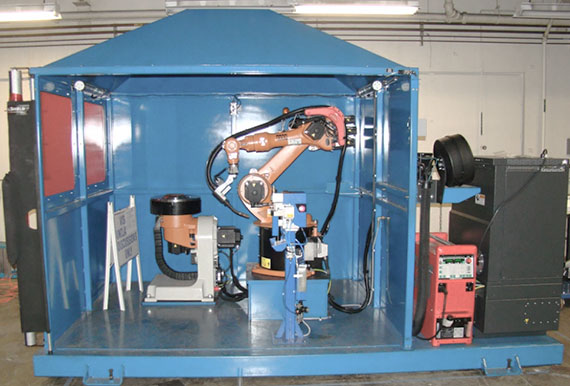John Elmer | 18-FS-040
Overview
The goal of this feasibility study was to demonstrate the ability to additively manufacture three-dimensional parts from atmosphere-sensitive reactive alloys such as titanium and tantalum using a robotically controlled wire-arc additive-manufacturing (WAAM) technique. New WAAM welding parameters were successfully developed for a titanium alloy (Ti-6Al-4V) and tantalum, both of which are very sensitive to atmospheric contamination during the welding process. Using these parameters and controlled gas purging inside the glove box with varying levels of oxygen, successful WAAM builds were made and chemically analyzed. The results were used to determine minimum purge requirements for WAAM builds of components in 308L SS, Ti-6Al-4V, and Ta to produce parts without significant uptakes of oxygen or nitrogen.
Background and Research Objectives
Wire arc additive manufacturing is one of the four high-deposition-rate (HDR) additive-manufacturing (AM) processes currently in use. The power sources of three of the four processes—electron beam (EBAM), laser (LAM), and arc (WAAM)—use wire as the feedstock while the fourth process—directed energy deposition (DED)—uses high-feed-rate blown powders and laser heat sources. All four HDR processes use high power levels (i.e., thousands of kilowatts) and can fabricate parts at build rates of thousands of kilograms per hour. These processes are distinguished from laser or electron-beam powder-bed welding processes in that they are not confined to prescribed dimensions, have much higher deposition rates, have no size restrictions, and are significantly more economical in terms of the cost and amount of material deposited. The WAAM processes can produce thin-wall, thick-wall, solid, and cast-like components without the need for a die and can produce microstructures that are more refined and have smaller grains and better properties than castings. In addition, WAAM can be used to build onto existing structures, modify existing parts through cladding and hard-facing, and repair and maintain castings and other metal parts.
To take advantage of the HDR wire-based metal AM processes, Lawrence Livermore National Laboratory uses a robotically controlled WAAM. The figure below is a photograph of the Laboratory's robot cell used in this study.
Photograph of the eight-axis robot cell for welding and wire-arc additive manufacturing.
Previously, researchers sought to characterize the microstructure and understand the properties of the WAAM-deposited metal. Some basic research was performed on the 308L stainless steel builds resulting in tensile properties with higher yield strength, similar ultimate strength, and favorable elongation to failure when compared to its 304L stainless-steel wrought counterpart.
As part of our study, we compared the chemical compositions of the 308L stainless-steel WAAM builds to the wire's starting composition and established technical specifications for this wire. The only chemical element from the build that fell out of specification was oxygen (O 2 ), which is picked up as the hot WAAM parts (with inadequate inert-gas shielding) cool to room temperature.
Although a small amount of oxygen pickup is not detrimental to stainless-steel welds (due to deoxidizers such as silicon that are present in the stainless steel), other metals and alloys are more readily affected by atmosphere contamination, and their mechanical properties can be adversely affected by the pickup of air during welding or WAAM. Alloys of interest that will require more effective inert-gas shielding are titanium, magnesium, zirconium, uranium, and refractory metals such as tantalum, tungsten, and molybdenum. These metal alloys can experience a significant decrease in ductility when exposed to oxygen, nitrogen, or hydrogen at elevated temperatures. Our goal was to demonstrate that these metals and alloys can be successfully fabricated using the WAAM process with adequate inert-gas shielding.
Impact on Mission
The use of WAAM techniques for reactive alloys is relatively new and has great potential for use in many applications. Lawrence Livermore National Laboratory's AM program may adopt WAAM for use in conjunction with laser powder-bed AM. The Laboratory's weapons programs may find applications for reactive metal component fabrication as an alternative to casting or wrought processing. In addition, WAAM techniques can be used to augment EBAM with wire-feed capability.
Conclusion
It is important to note that the Laboratory brought the first (and currently only) WAAM system in the DOE complex online, so we are in a position to continue to lead in this area of research. The demonstration of purge requirements for 308L stainless steel, Ti-6-4, and tantalum performed as part of this feasibility study show that only moderate purge levels are required to produce desirable chemistries from reactive metals, which leads the way to the design of a realistic inert robot cell. Recommended next steps include designing and purchasing a complete, inert WAAM robot cell with the necessary features for adequate purge to fabricate full-sized components and parts under inert conditions.






